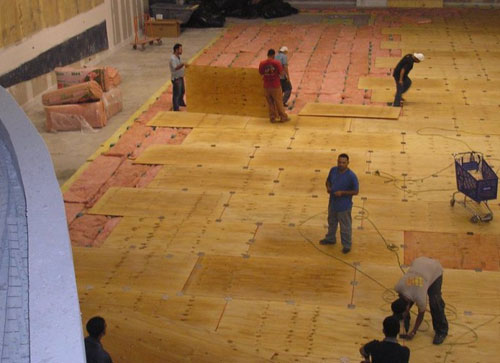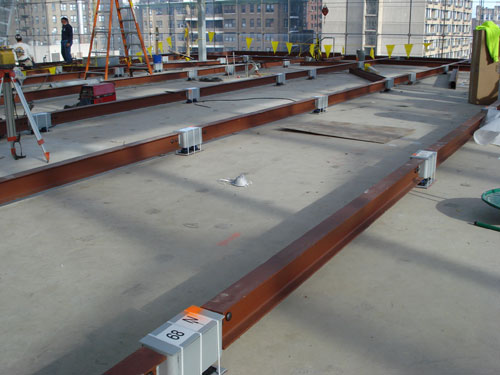Noise Control and Room Acoustics in Building Design
Stud wall framing design affects sound
The design of stud walls can significantly improve noise control. A single stud wall with a single gypsum board on each side has a low STC of 33. By redesigning the stud design and adding resilient isolation clips STC can be doubled.
Double stud. Double 2 x 4 stud wall with two layers of 5/8 gypsum board each side, provides STC 63.While effective for high STC, the two walls take additional floor space. Note, rigid bracing between walls, often done for fire rated design, will drastically lower the STC.
Staggered stud. While much less effective than double stud construction due to common base plates which transmit sound, staggered stud construction with an STC of 53 takes less floor space.
Resilient clip single stud. Using resilient isolation clips can provide a high STC of 61 and maximizes floor space.
Wall braces are available in different configurations and will isolate soffits, stud walls, plumbing and TV sound.
| Floor Isolation System for Bowling Alley: Galaxy Lanes at Plaza Las Americas: San Juan, Puerto Rico |
||
When the owners of Galaxy Lanes at Plaza Las Americas proposed a 32-lane bowling alley be located on the third floor of the largest mall in the Caribbean, the mall owners and store operators on the floors below demanded that no sound of bowling balls and pins and no airborne music be heard during business hours. Typically, spring isolators supporting a concrete slab are chosen to address impact from bowling noise. However, once the cost and construction time of the system were understood, an alternative system was sought that used roll-out material with isolators. Roll-out batting with 4-in.-tall fiberglass isolators inserted 24-in. on center plus an additional layer of batting was laid. A ¾-in.-thick plywood sheathing pouring form was installed on top and tied together using junction plates. Poly sheeting protected the pouring form. Altogether, two four-man crews each working 8-hour shifts, completed the task in three and a half days, ready for reinforcement and poring the concrete. The effort allowed the concrete contractor to start work a week early. The bowling alley manufacturer was then able to commence installation of the lanes as originally scheduled. |
| Column and Floor Isolator Assemblies: Kimmel Center Hamilton Terrace Philadelphia, PA |
||
Special spring assemblies were manufactured for isolating the columns and floor for the new Hamilton Terrace entertainment venue at Kimmel Center in Philadelphia, Pennsylvania, home of the legendary Philadelphia Orchestra. Engaged by the acoustical consulting firm Threshold Acoustics, the manufacturer was challenged with designing isolators to fully decouple the venue from the rest of the Kimmel Center structure. Two independent isolation systems were proposed, so that the variable live load on the isolated floor would not affect the isolation and detailing of the superstructure. First, column isolators had to be designed to meet height requirements, provide vertical and lateral restraint, minimize demolition to the existing structural floor, facilitate easy installation at the jobsite, and meet the specified design frequency. Next, spring isolators were designed to allow steel structural members for the floor system to be connected. Accurate load information coupled with proper spring selection yielded a floating floor system capable of handling a varied dead load imposed across the floor and varying live load input, all without significant movement to the floor during events. Opened during summer 2012, the column and floor isolators performed flawlessly. Critical to the success of this project were the manufacturer’s early involvement in the project with the design team and close coordination with the structural engineer of record. |
Conclusion
Architectural construction systems and finishes are engineered, designed and specified to deliver noise control. Strategies for controlling in-room noise include surface finish treatments such as acoustical panels that reflect, absorb and diffuse sound for a range of applications such as concert halls, swimming pools and auditoriums. Wall, floor and ceiling architectural framing designs that incorporate sound isolation products play a major role in controlling sound between rooms. Recognized as a significant factor in school design, adequate noise control is a growing requirement of building design and an increasing presence in LEED certification.
 |
Celebrating over 50 years, Kinetics Noise Control has extensive experience in designing and manufacturing innovative products to control sound and vibration. Established in 1958 as engineers focusing on sound and vibration control, Kinetics pioneered development of pre-compressed, molded fiberglass pad isolators that would be incorporated into an innovative new floor isolation system. Previous trade names of Kinetics Noise Control include Consolidated Kinetics and Peabody Noise Control. www.kineticsnoise.com |










